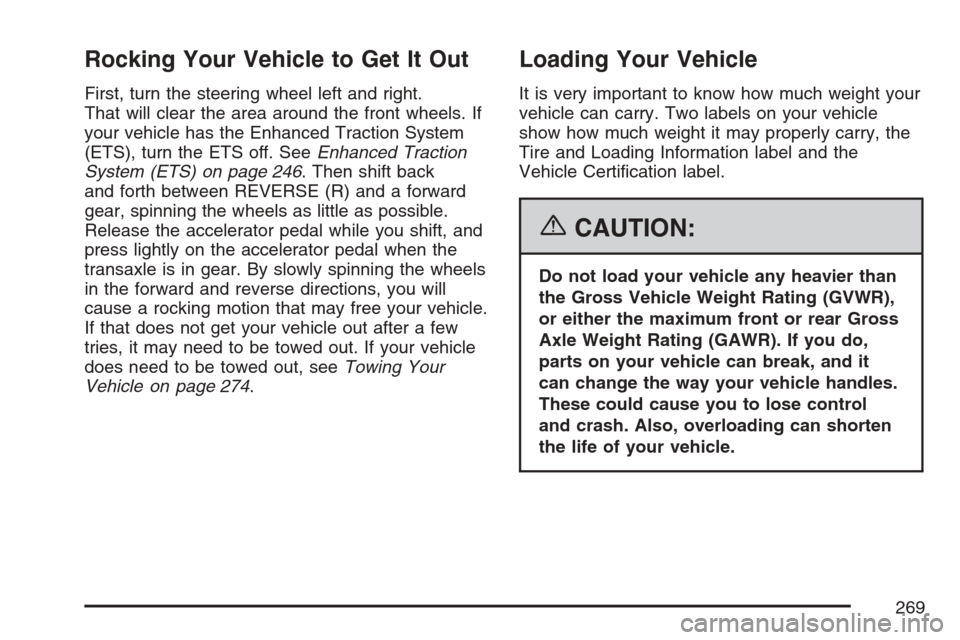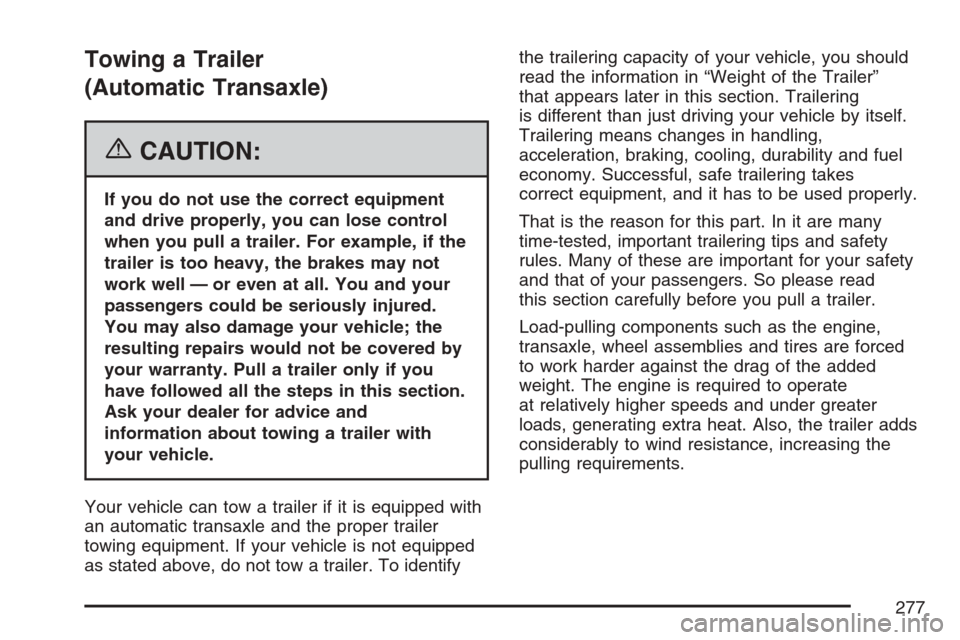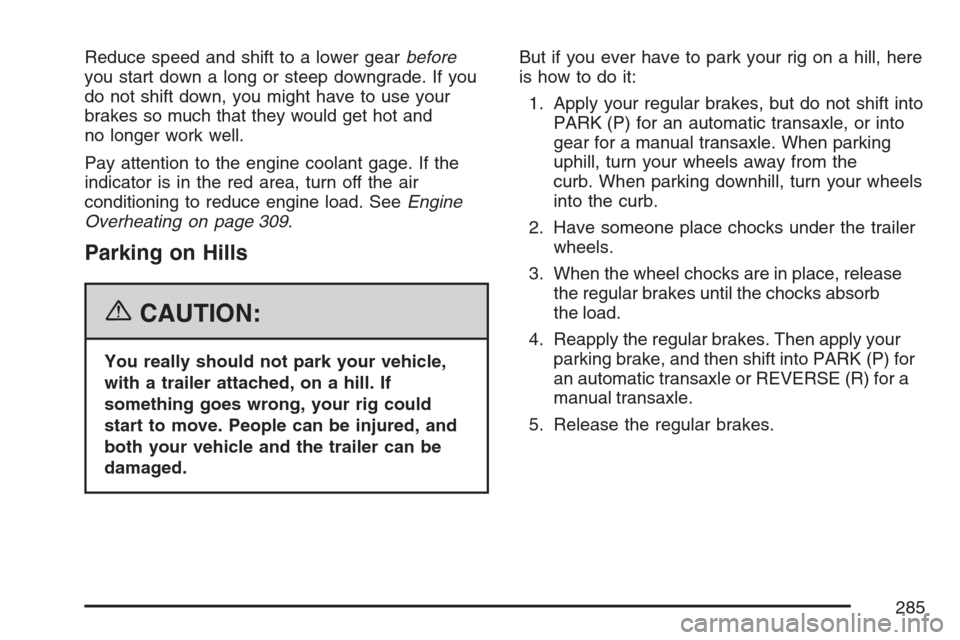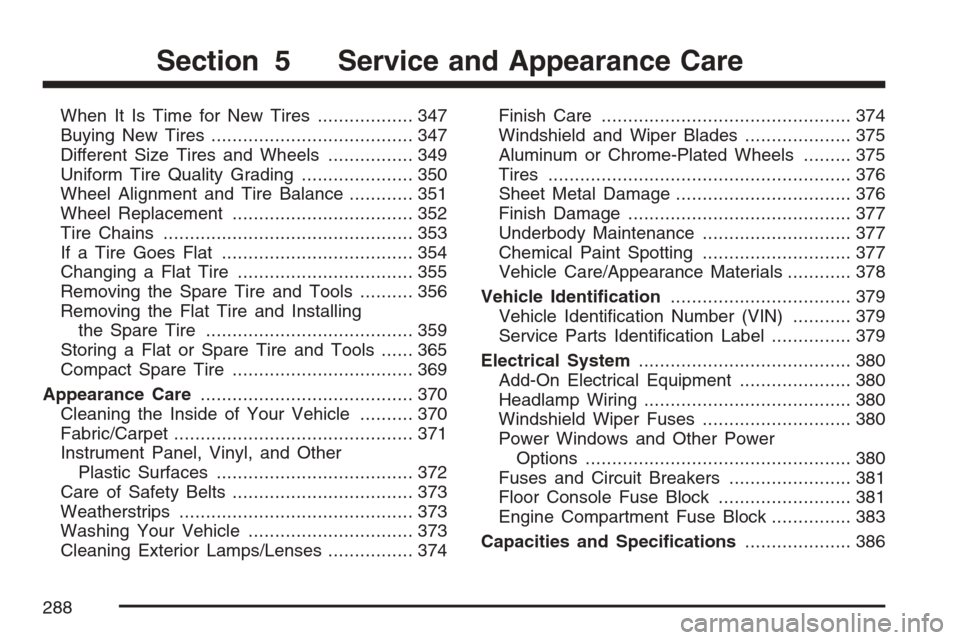2007 CHEVROLET HHR wheel
[x] Cancel search: wheelPage 268 of 446

You will need a well-charged battery to restart the
vehicle, and possibly for signaling later on with
the headlamps. Let the heater run for a while.
Then, shut the engine off and close the window
almost all the way to preserve the heat. Start
the engine again and repeat this only when you
feel really uncomfortable from the cold. But do it as
little as possible. Preserve the fuel as long as
you can. To help keep warm, you can get out of
the vehicle and do some fairly vigorous exercises
every half hour or so until help comes.
If Your Vehicle is Stuck in Sand,
Mud, Ice, or Snow
In order to free your vehicle when it is stuck,
you will need to spin the wheels, but you do not
want to spin your wheels too fast. The method
known as rocking can help you get out when you
are stuck, but you must use caution.
If your vehicle has the Enhanced Traction System
(ETS), the ETS can often help to free a stuck
vehicle. SeeEnhanced Traction System (ETS) on
page 246. If the stuck condition is too severe
for the ETS to free the vehicle, turn the ETS off
and use the rocking method.
{CAUTION:
If you let your vehicle’s tires spin at high
speed, they can explode, and you or others
could be injured. And, the transaxle or
other parts of the vehicle can overheat.
That could cause an engine compartment
�re or other damage. When you are stuck,
spin the wheels as little as possible. Do not
spin the wheels above 35 mph (55 km/h) as
shown on the speedometer.
Notice:Spinning the wheels can destroy parts
of your vehicle as well as the tires. If you spin
the wheels too fast while shifting the transaxle
back and forth, you can destroy the transaxle.
SeeRocking Your Vehicle to Get It Out on
page 269.
For information about using tire chains on your
vehicle, seeTire Chains on page 353.
268
Page 269 of 446

Rocking Your Vehicle to Get It Out
First, turn the steering wheel left and right.
That will clear the area around the front wheels. If
your vehicle has the Enhanced Traction System
(ETS), turn the ETS off. SeeEnhanced Traction
System (ETS) on page 246. Then shift back
and forth between REVERSE (R) and a forward
gear, spinning the wheels as little as possible.
Release the accelerator pedal while you shift, and
press lightly on the accelerator pedal when the
transaxle is in gear. By slowly spinning the wheels
in the forward and reverse directions, you will
cause a rocking motion that may free your vehicle.
If that does not get your vehicle out after a few
tries, it may need to be towed out. If your vehicle
does need to be towed out, seeTowing Your
Vehicle on page 274.
Loading Your Vehicle
It is very important to know how much weight your
vehicle can carry. Two labels on your vehicle
show how much weight it may properly carry, the
Tire and Loading Information label and the
Vehicle Certi�cation label.
{CAUTION:
Do not load your vehicle any heavier than
the Gross Vehicle Weight Rating (GVWR),
or either the maximum front or rear Gross
Axle Weight Rating (GAWR). If you do,
parts on your vehicle can break, and it
can change the way your vehicle handles.
These could cause you to lose control
and crash. Also, overloading can shorten
the life of your vehicle.
269
Page 274 of 446

If you put things inside your vehicle — like
suitcases, tools, packages, or anything
else — they will go as fast as the vehicle goes.
If you have to stop or turn quickly, or if there is a
crash, they will keep going.
{CAUTION:
Things you put inside your vehicle can
strike and injure people in a sudden stop
or turn, or in a crash.
Put things in the cargo area of your
vehicle. Try to spread the weight
evenly.
Never stack heavier things, like
suitcases, inside the vehicle so that
some of them are above the tops of
the seats.
Do not leave an unsecured child
restraint in your vehicle.
When you carry something inside the
vehicle, secure it whenever you can.
Do not leave a seat folded down
unless you need to.
Towing
Towing Your Vehicle
Consult your dealer or a professional towing
service if you need to have your disabled vehicle
towed. SeeRoadside Assistance Program on
page 418.
If you want to tow your vehicle behind another
vehicle for recreational purposes (such as behind
a motorhome), see “Recreational Vehicle
Towing” following.
Recreational Vehicle Towing
Recreational vehicle towing means towing your
vehicle behind another vehicle — such as behind a
motorhome. The two most common types of
recreational vehicle towing are known as “dinghy
towing” (towing your vehicle with all four wheels
on the ground) and “dolly towing” (towing
your vehicle with two wheels on the ground and
two wheels up on a device known as a “dolly”).
274
Page 275 of 446

With the proper preparation and equipment, many
vehicles can be towed in these ways. See
“Dinghy Towing” and “Dolly Towing,” following.
Here are some important things to consider before
you do recreational vehicle towing:
What is the towing capacity of the towing
vehicle? Be sure you read the tow vehicle
manufacturer’s recommendations.
How far will you tow? Some vehicles have
restrictions on how far and how long they
can tow.
Do you have the proper towing equipment?
See your dealer or trailering professional
for additional advice and equipment
recommendations.
Is your vehicle ready to be towed? Just as
you would prepare your vehicle for a long
trip, you will want to make sure your vehicle is
prepared to be towed. SeeBefore Leaving
on a Long Trip on page 260.
Dinghy Towing
You may dinghy tow your vehicle from the front
following these steps:
1. Set the parking brake.
2. Turn the ignition key to ACC to unlock the
steering wheel.
3. Shift your transaxle to NEUTRAL (N).
4. Release the parking brake.
275
Page 277 of 446

Towing a Trailer
(Automatic Transaxle)
{CAUTION:
If you do not use the correct equipment
and drive properly, you can lose control
when you pull a trailer. For example, if the
trailer is too heavy, the brakes may not
work well — or even at all. You and your
passengers could be seriously injured.
You may also damage your vehicle; the
resulting repairs would not be covered by
your warranty. Pull a trailer only if you
have followed all the steps in this section.
Ask your dealer for advice and
information about towing a trailer with
your vehicle.
Your vehicle can tow a trailer if it is equipped with
an automatic transaxle and the proper trailer
towing equipment. If your vehicle is not equipped
as stated above, do not tow a trailer. To identifythe trailering capacity of your vehicle, you should
read the information in “Weight of the Trailer”
that appears later in this section. Trailering
is different than just driving your vehicle by itself.
Trailering means changes in handling,
acceleration, braking, cooling, durability and fuel
economy. Successful, safe trailering takes
correct equipment, and it has to be used properly.
That is the reason for this part. In it are many
time-tested, important trailering tips and safety
rules. Many of these are important for your safety
and that of your passengers. So please read
this section carefully before you pull a trailer.
Load-pulling components such as the engine,
transaxle, wheel assemblies and tires are forced
to work harder against the drag of the added
weight. The engine is required to operate
at relatively higher speeds and under greater
loads, generating extra heat. Also, the trailer adds
considerably to wind resistance, increasing the
pulling requirements.
277
Page 283 of 446

Driving with a Trailer
Towing a trailer requires a certain amount of
experience. Before setting out for the open road,
you will want to get to know your rig. Acquaint
yourself with the feel of handling and braking with
the added weight of the trailer. And always
keep in mind that the vehicle you are driving is
now a good deal longer and not nearly as
responsive as your vehicle is by itself.
Before you start, check all trailer hitch parts and
attachments, safety chains, electrical connector,
lamps, tires and mirror adjustment. If the trailer has
electric brakes, start your vehicle and trailer
moving and then apply the trailer brake controller
by hand to be sure the brakes are working.
This lets you check your electrical connection at
the same time.
During your trip, check occasionally to be sure
that the load is secure, and that the lamps and any
trailer brakes are still working.
Following Distance
Stay at least twice as far behind the vehicle ahead
as you would when driving your vehicle without
a trailer. This can help you avoid situations
that require heavy braking and sudden turns.
Passing
You will need more passing distance up ahead
when you are towing a trailer. And, because
the vehicle is a good deal longer, you will need to
go much farther beyond the passed vehicle
before you can return to your lane.
Backing Up
Hold the bottom of the steering wheel with one
hand. Then, to move the trailer to the left,
just move that hand to the left. To move the trailer
to the right, move your hand to the right. Always
back up slowly and, if possible, have someone
guide you.
283
Page 285 of 446

Reduce speed and shift to a lower gearbefore
you start down a long or steep downgrade. If you
do not shift down, you might have to use your
brakes so much that they would get hot and
no longer work well.
Pay attention to the engine coolant gage. If the
indicator is in the red area, turn off the air
conditioning to reduce engine load. SeeEngine
Overheating on page 309.
Parking on Hills
{CAUTION:
You really should not park your vehicle,
with a trailer attached, on a hill. If
something goes wrong, your rig could
start to move. People can be injured, and
both your vehicle and the trailer can be
damaged.But if you ever have to park your rig on a hill, here
is how to do it:
1. Apply your regular brakes, but do not shift into
PARK (P) for an automatic transaxle, or into
gear for a manual transaxle. When parking
uphill, turn your wheels away from the
curb. When parking downhill, turn your wheels
into the curb.
2. Have someone place chocks under the trailer
wheels.
3. When the wheel chocks are in place, release
the regular brakes until the chocks absorb
the load.
4. Reapply the regular brakes. Then apply your
parking brake, and then shift into PARK (P) for
an automatic transaxle or REVERSE (R) for a
manual transaxle.
5. Release the regular brakes.
285
Page 288 of 446

When It Is Time for New Tires.................. 347
Buying New Tires...................................... 347
Different Size Tires and Wheels................ 349
Uniform Tire Quality Grading..................... 350
Wheel Alignment and Tire Balance............ 351
Wheel Replacement.................................. 352
Tire Chains............................................... 353
If a Tire Goes Flat.................................... 354
Changing a Flat Tire................................. 355
Removing the Spare Tire and Tools.......... 356
Removing the Flat Tire and Installing
the Spare Tire....................................... 359
Storing a Flat or Spare Tire and Tools...... 365
Compact Spare Tire.................................. 369
Appearance Care........................................ 370
Cleaning the Inside of Your Vehicle.......... 370
Fabric/Carpet............................................. 371
Instrument Panel, Vinyl, and Other
Plastic Surfaces..................................... 372
Care of Safety Belts.................................. 373
Weatherstrips............................................ 373
Washing Your Vehicle............................... 373
Cleaning Exterior Lamps/Lenses................ 374Finish Care............................................... 374
Windshield and Wiper Blades.................... 375
Aluminum or Chrome-Plated Wheels......... 375
Tires......................................................... 376
Sheet Metal Damage................................. 376
Finish Damage.......................................... 377
Underbody Maintenance............................ 377
Chemical Paint Spotting............................ 377
Vehicle Care/Appearance Materials............ 378
Vehicle Identi�cation.................................. 379
Vehicle Identi�cation Number (VIN)........... 379
Service Parts Identi�cation Label............... 379
Electrical System........................................ 380
Add-On Electrical Equipment..................... 380
Headlamp Wiring....................................... 380
Windshield Wiper Fuses............................ 380
Power Windows and Other Power
Options.................................................. 380
Fuses and Circuit Breakers....................... 381
Floor Console Fuse Block......................... 381
Engine Compartment Fuse Block............... 383
Capacities and Speci�cations.................... 386
Section 5 Service and Appearance Care
288